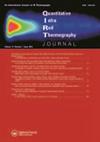New computer aided diagnostic system using deep neural network and SVM to detect breast cancer in thermography
IF 4.9
3区 工程技术
Q1 INSTRUMENTS & INSTRUMENTATION
引用次数: 10
Abstract
ABSTRACT Mammography is widely used for identifying breast cancer. However, this technique is invasive, which causes X-ray tissue damage and very often fails to detect a certain tumour size. Thermography is another alternative, being non-ionising, non-invasive and able to detect abnormal breast conditions at an early stage. In this paper, we propose a new computer-aided diagnosis system based on artificial intelligence and thermography to help radiologists correctly diagnose breast diseases. One hundred and seventy infrared breast images are collected from an open-source database to feed a deep learning algorithm for automatic segmentation of breast thermograms. An intersection over a union of 89.03% is practically obtained using the U-net model. Textural evaluation and vascular network analysis are performed on the segmented thermograms to extract relevant features. Classifiers based on supervised learning algorithms are implemented using the extracted features to distinguish normal from abnormal thermograms. . We achieved an accuracy of 94.4%, a precision of 96.2%, a recall of 86.7%, an F1-score of 91.2% and a true negative rate of 98.3% when the developed approach was applied on a support vector machine. These two obtained results concerning both segmentation and classification are considered very motivating and encouraging compared to up-to-date methods.基于深度神经网络和支持向量机的乳腺癌热成像诊断系统
乳房x光检查被广泛用于乳腺癌的诊断。然而,这种技术是侵入性的,它会导致x射线组织损伤,并且经常无法检测到一定大小的肿瘤。热成像是另一种选择,是非电离的,非侵入性的,能够在早期发现异常的乳房状况。本文提出了一种新的基于人工智能和热成像的计算机辅助诊断系统,以帮助放射科医生正确诊断乳腺疾病。从一个开源数据库中收集170张红外乳房图像,为乳房热像图的自动分割提供深度学习算法。用U-net模型实际得到了89.03%的并集交点。对分割后的热图进行纹理评价和血管网络分析,提取相关特征。基于监督学习算法的分类器使用提取的特征来区分正常和异常的热图。将该方法应用于支持向量机,准确率为94.4%,精密度为96.2%,召回率为86.7%,f1得分为91.2%,真阴性率为98.3%。与最新的方法相比,这两个关于分割和分类的结果被认为是非常鼓舞人心的。
本文章由计算机程序翻译,如有差异,请以英文原文为准。
求助全文
约1分钟内获得全文
求助全文
来源期刊

Quantitative Infrared Thermography Journal
Physics and Astronomy-Instrumentation
CiteScore
6.80
自引率
12.00%
发文量
17
审稿时长
>12 weeks
期刊介绍:
The Quantitative InfraRed Thermography Journal (QIRT) provides a forum for industry and academia to discuss the latest developments of instrumentation, theoretical and experimental practices, data reduction, and image processing related to infrared thermography.
 求助内容:
求助内容: 应助结果提醒方式:
应助结果提醒方式:


